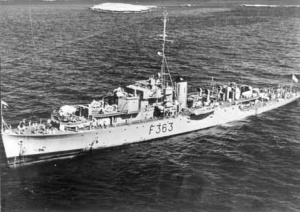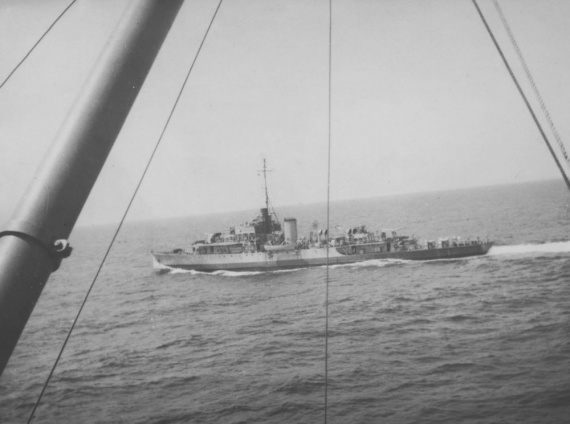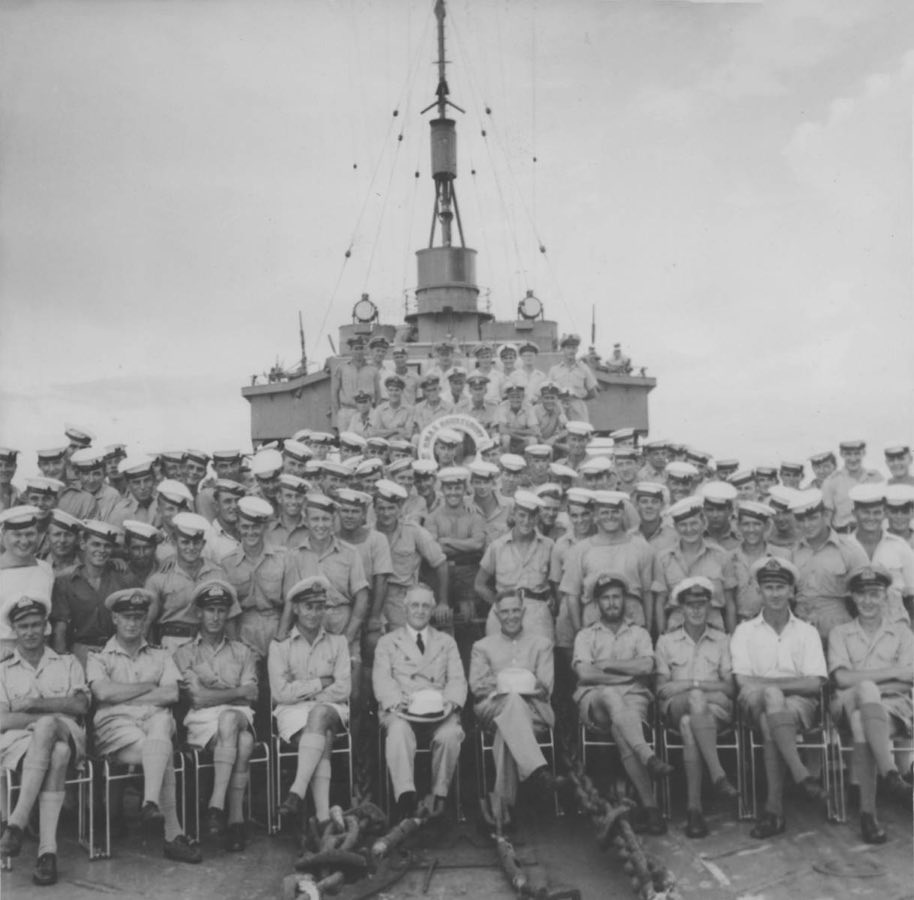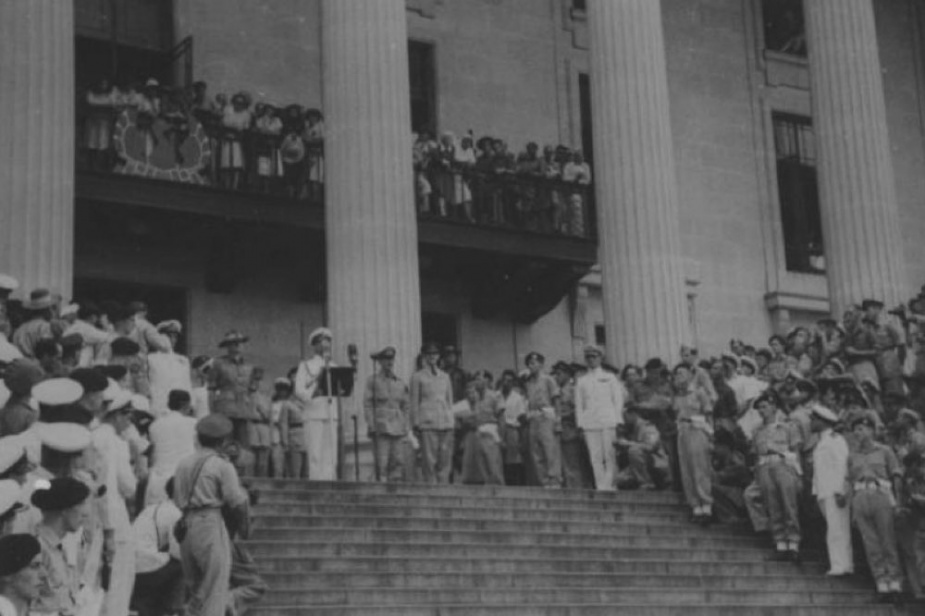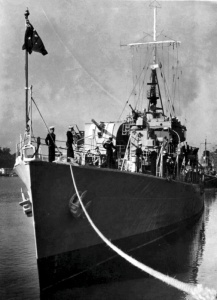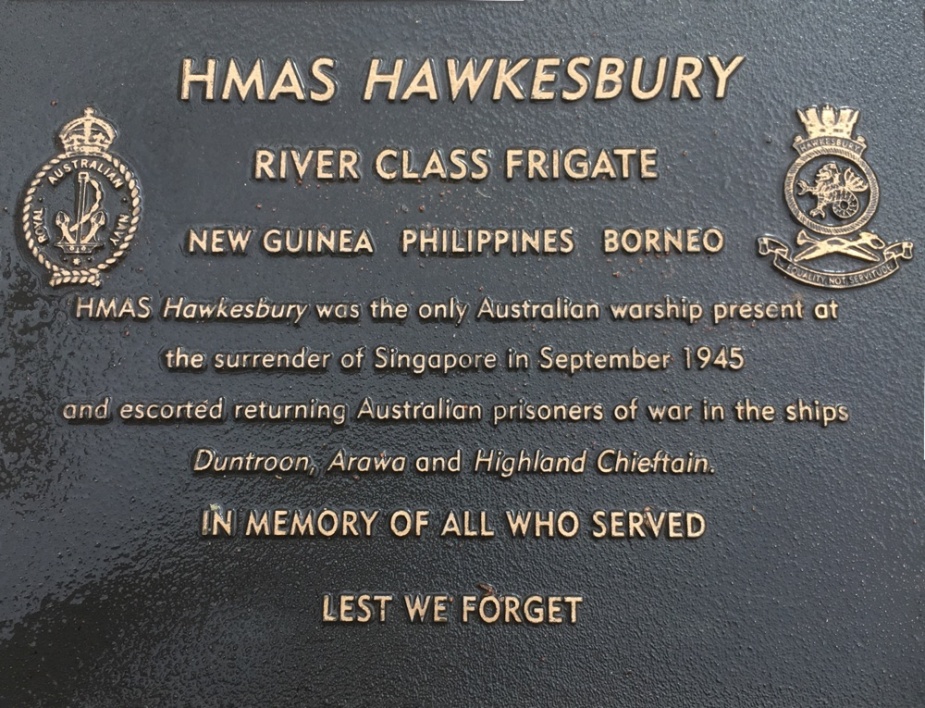HMAS Hawkesbury (I)
| Class |
River Class |
|---|---|
| Type |
Frigate |
| Pennant |
K363 |
| Builder |
Mort's Dock & Engineering Co Ltd, Sydney |
| Laid Down |
24 August 1942 |
| Launched |
24 July 1943 |
| Launched by |
Mrs Ashley, wife of the Postmaster-General |
| Commissioned |
5 July 1944 |
| Decommissioned |
14 February 1955 |
| Dimensions & Displacement | |
| Displacement |
|
| Length | 301 feet 4 inches (overall) |
| Beam | 36 feet 2 inches |
| Draught | 12 feet |
| Performance | |
| Speed | 20 knots |
| Complement | |
| Crew | 140 |
| Propulsion | |
| Machinery | Triple expansion, 2 shafts |
| Horsepower | 5500 |
| Armament | |
| Guns |
|
| Other Armament |
|
| Awards | |
| Battle Honours | |
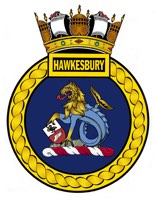
HMAS Hawkesbury was ordered as part of Australia's shipbuilding program during the Second World War. Twelve of these Australian built frigates were to enter service with the Royal Australian Navy. A further ten were ordered but cancelled as the war drew to a close.
Eight, HMA Ships Barcoo, Barwon, Burdekin, Diamantina, Gascoyne, Hawkesbury, Lachlan and Macquarie, were built to the British River Class design and Australia likewise named its frigates after Australian rivers. A further four, HMA Ships Condamine, Culgoa, Murchison and Shoalhaven, were also named after Australian rivers but were built to the design of the Royal Navy's Bay Class Frigates. These latter ships were generally known as Modified River Class Frigates although they are sometimes referred to as Bay Class.
Hawkesbury commissioned at Sydney on 5 July 1944 under the command of Lieutenant Commander Howard J Weston RANR(S).
After trials on the Australian east coast she proceeded to New Guinea waters for convoy escort duty, based at Manus Island.
On 26 September Hawkesbury was called upon to assist the burning tanker Misson Ridge following her collision with the Liberty Ship Don Marquis. After taking off the crew she succeeded in quelling the flames using hoses and fire parties.
On 10 November 1944 Hawkesbury was shaken by the disastrous explosion of the American ammunition ship Mount Hood in Seeadler Harbour, but escaped damage.
In December 1944 she continued her escort duties from Manus, including the duty of escorting a troop convoy, comprising the United States 81st Infantry Division, from Peleiu to the Russell Islands. On 20 December she returned to Brisbane, completing four months service in the forward operational areas.
In January 1945 Hawkesbury embarked the Honourable Mr NJO Makin, the Minister for the Navy, for a tour of northern naval establishment, visiting Townsville, Cairns, Thursday Island and Darwin. On 18 January the frigate returned to New Guinea when she arrived at Madang.
At Hollandia on 20 January she came under the control of the Commander Philippine Sea Frontier (Escort Group) for escort duties to Leyte Gulf in the Philippines. After completing this task and patrols and escort in Philippine waters, she returned to Hollandia on 14 February. On 18 February Hawkesbury again sailed on escort duties for Leyte, acting as one of the screen to 70 miscellaneous units including dry docks.
In the period of March to April 1945, Hawkesbury continued escort duties for convoys in New Guinea and the Philippines. On 14 April she reached Hollandia from Leyte and then proceeded to Morotai, spending a few days on patrol.
On 27 April she sailed from Morotai as a unit of the escort for the first of the Australian landings in Borneo, at Tarakan, later acting as a fire support ship to the troops ashore until 7 May when she proceeded to Leyte escorting a American fleet tanker. There was further escort duty between Borneo and the Philippines in May, the month closing with Hawkesbury lying in San Pedro Bay.
In June 1945 Hawkesbury took part in the Brunei Bay landings in Borneo and later supporting supply operations from Morotai. In July she spent a period collecting enemy intelligence in the Moluccas, and with HMAS Cape Leeuwin established lighthouses for the reopening of the Darwin to Morotai shipping route. Diversion from routine was experienced on 22 July when she bombarded Japanese positions on Jariffi Island. On 27 July the erection of lights on Boo Besar Island was completed and Hawkesbury set course for Sydney via Thursday Island.
Following a short refit in Sydney Hawkesbury sailed on 29 August 1945 escorting the repatriation transport MV Duntroon for Singapore. She remained in Singapore until 20 September, awaiting the embarkation of Australian prisoners of war. Darwin was reached on the last day of September and the following day Hawkesbury sailed for Timor to take part in the Japanese surrender ceremony at Singapore on 3 October.
Japanese installations were inspected at various points including Ambon, between 8 and 12 October, followed by a three day visit to Borneo. October closed with Hawkesbury engaged on a reconnaissance of the Celebes and the Banggai and Soela Islands. At Gorontalo, on 31 October, her ship's company took part in a colourful ceremony proclaiming the defeat of Japan to the local Rajah and his people.
Surveillance duties continued until 8 November when Hawkesbury arrived at Ternate to disembark the Sultan of the region. Places visited were Menado, Gorontalo, Parigi, Poso, Banggai, Taliaboe, Sanama and Ternate. Except for Menado and Ternate, she was the first Allied vessel to visit these points after the Japanese occupation.
On 12 November 1945 Hawkesbury sailed from Morotai and after visiting Amboina proceeded for Sydney, bringing to a close her wartime career. At the end of November she entered Port Phillip Bay and commenced a refit at Williamstown. In the seventeen months that had elapsed since her commissioning, Hawkesbury steamed 81,056 miles and spent almost 6000 hours underway.
In April 1946 Hawkesbury, after a four month refit, took up duty as a unit of the Australian Squadron on the east coast. After thirteen months in New South Wales and Queensland waters, including five months in Sydney Harbour, she paid off into Reserve on 31 May 1947.
Five years in Reserve ended on 14 May 1952 when Hawkesbury recommissioned under the command of Lieutenant Commander John P Stevenson RAN.
On 31 July 1952, at Fremantle, Hawkesbury transferred to the operational control of the Fourth Task Force of the Royal Navy as a unit of the First Frigate Squadron (Senior Officer in HMAS Shoalhaven). The next three months were spent on operations in support of first British atomic test in the Monte Bello Islands. Hawkesbury's conducted security patrols in the prohibited areas, and served as a despatch vessel between Onslow and the area of operations.
On 31 October the British Task Force left the area. Hawkesbury continued security patrols on the north west coast until 15 January 1953 when she finally left Monte Bello en route for Sydney where she remained for most of the following months. A refit and training ship duties occupied much of this period. In September she acted as a radio control ship for the Sydney to Noumea Yacht Race, coinciding with the New Caledonian Centenary Celebrations.
In November 1953 Hawkesbury proceeded to the South West Pacific area, arriving at Manus on 26 November where she relieved HMAS Shoalhaven on the northern waters patrol.
Hawkesbury spent the period of December 1953 to April 1954 in tropical waters showing the flag and collecting hydrographic data. Many points in New Guinea, New Britain, the Solomon Islands and smaller island groups were visited, and she had steamed nearly 9000 miles by the time she returned to Sydney on 21 April 1954.
The winter months of 1954 were spent in the Sydney area. On 8 August she arrived in Darwin to begin a period on patrol in the Arafura and Timor Seas, policing Japanese Pearling Fleet operations. On 19 September she embarked the Prime Minister, the Right Honourable RG Menzies, and his family for a visit to the Japanese Pearling Fleet then lying off Bathurst Island. The patrols ended on 27 September when Hawkesbury finally parted from the Japanese Pearling Fleet in the Arafura Sea.
On 30 September the frigate arrived at Port Moresby to commence a further series of northern patrols. Ocean and Nauru Islands were visited during October and the Solomon Islands in November. On 6 November a Japanese sampan, caught poaching in the Nuguria Islands, was arrested and her crew transported to Rabual for trial.
Hawkesbury's second tour of duty on the northern patrol ended in December 1954 when she returned to Sydney for a refit and to prepare for paying off. Hawkesbury paid off on 14 February 1955 after she had steamed 52,000 miles during her second commission.
Hawkesbury was not again brought into commission. After being declared for disposal early in 1961, she was sold to the Tolo Mining and Smelting Co Ltd of Hong Kong on 21 September 1961. She was later resold to a Japanese firm, Amakasu Sangyo Kisen Co Ltd, but remained at her Navy mooring until 7 September 1962. During that month Hawkesbury and her sister ship Murchison, also bought by the Japanese firm, left Sydney under tow, bound for the Far East to be broken up.

